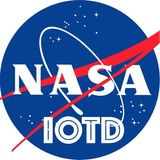This artist's conception illustrates a Jupiter-like planet alone in the dark of space, floating freely without a parent star. http://www.nasa.gov/sites/default/files/images/549310main_pia14093-43_full.jpg
The seven-member Expedition 65 crew gathered for a portrait inside the International Space Station. http://www.nasa.gov/sites/default/files/thumbnails/image/iss065e440627.jpg
This NASA/ESA Hubble Space Telescope image features two interacting galaxies that are so intertwined, they have a collective name – Arp 91. http://www.nasa.gov/sites/default/files/thumbnails/image/potw2140a.jpg
A violent and chaotic-looking mass of gas and dust is seen in this Hubble Space Telescope image of a nearby supernova remnant. http://www.nasa.gov/sites/default/files/images/117227main_image_feature_342_ys_full.jpg
NASA's Lucy mission will explore a record-breaking number of asteroids. http://www.nasa.gov/sites/default/files/thumbnails/image/lucytargetspreview.jpg
With the Lucy spacecraft aboard, a United Launch Alliance Atlas V rocket is seen as it is rolled out of the Vertical Integration Facility. http://www.nasa.gov/sites/default/files/thumbnails/image/51588477876_00484cf555_o.jpeg
Concept for a set of future robots working together to ferry back samples from the surface of Mars collected by the Mars Perseverance rover. http://www.nasa.gov/sites/default/files/thumbnails/image/pia24870.jpeg
A vivid aurora streams over the Earth as the International Space Station orbited 274 miles above the southern Indian Ocean. http://www.nasa.gov/sites/default/files/thumbnails/image/iss065e473253.jpg
The Hubble Space Telescope's glamour shots of the universe nearly always have a discovery behind them. http://www.nasa.gov/sites/default/files/thumbnails/image/51545168002_ea41161857_o.png
Teams at NASA’s Kennedy Space Center in Florida lifted the Orion spacecraft and placed it atop the Space Launch System Moon rocket. http://www.nasa.gov/sites/default/files/thumbnails/image/artemisi.jpg
This celestial lightsaber does not lie in a galaxy far, far away, but rather inside our home galaxy, the Milky Way. http://www.nasa.gov/sites/default/files/thumbnails/image/hubble_lightsaber_image2.jpg
In June 2021, NASA received its first sample of asteroid Ryugu, which was returned to Earth in December 2020. http://www.nasa.gov/sites/default/files/thumbnails/image/jsc2021e022434.jpg
On October 8, 2014, active regions on our Sun gave it the appearance of a jack-o'-lantern. http://www.nasa.gov/sites/default/files/thumbnails/image/halloween_sun_2014.jpeg
Take a tour of some of the most terrifying and mind-blowing destinations in our galaxy ... and beyond. http://www.nasa.gov/sites/default/files/thumbnails/image/wallpaper_gamma_rays.jpeg
In this 90-second exposure, a SpaceX Falcon 9 rocket with the company's Crew Dragon spacecraft onboard is rolled to the launch pad on Oct. 27, 2021. http://www.nasa.gov/sites/default/files/thumbnails/image/51633780860_627133cf6c_o.jpeg
An aurora dimly intersected with Earth's airglow as the International Space Station flew into an orbital sunrise 264 miles above the Pacific Ocean. http://www.nasa.gov/sites/default/files/thumbnails/image/iss066e023536.jpg
An artists' impression of the Mariner 10 mission, the first mission to perform an interplanetary gravity assist. http://www.nasa.gov/sites/default/files/thumbnails/image/mariner_10_gravitational_slingshot.jpeg
The colorful planetary nebula, NGC 2438, formed after the death of a Sun-like star. It appears to lie on the outskirts of the open star cluster, M46 (NGC 2437), when in fact it is in the foreground between us and the star cluster. http://www.nasa.gov/sites/default/files/thumbnails/image/hubble_ngc2438_wfpc2_fullsize_1mb.jpg
The aurora borealis glow on the northern horizon while stars wheel overhead in this long exposure, taken near the Bonneville Salt Flats in Utah on Nov. 4, 2021. http://www.nasa.gov/sites/default/files/thumbnails/image/aurora_trails4.jpg
This image shows knots of cold, dense interstellar gas where new stars are forming. These Free-floating Evaporating Gaseous Globules (frEGGs) are located in the Northern Coalsack Nebula in the direction of Cygnus, the Swan. http://www.nasa.gov/sites/default/files/thumbnails/image/hubble_j2034417_freggs_fullsize_0.jpg
